Exploring Management: Literature Review on Structure and Intelligence
VerifiedAdded on 2023/04/22
|27
|6938
|484
Literature Review
AI Summary
This literature review provides an overview of management principles, organizational structures, performance metrics, collective intelligence, and human consciousness. It begins by examining traditional versus contemporary organizational structures, highlighting differences in centralization, flexibility, and hierarchy. The review explores the role of self-governance, HR processes, and organizational culture in shaping employee performance and innovation. Furthermore, it delves into performance indicators such as economic profit, value creation, productivity, and efficiency. The study also discusses the significance of collective intelligence, emotional intelligence, and motivational theories like Maslow's hierarchy of needs. Finally, it touches on human consciousness, world vision, and sustainability, emphasizing the importance of personal development within organizations. Desklib provides access to this and other solved assignments to aid students in their studies.
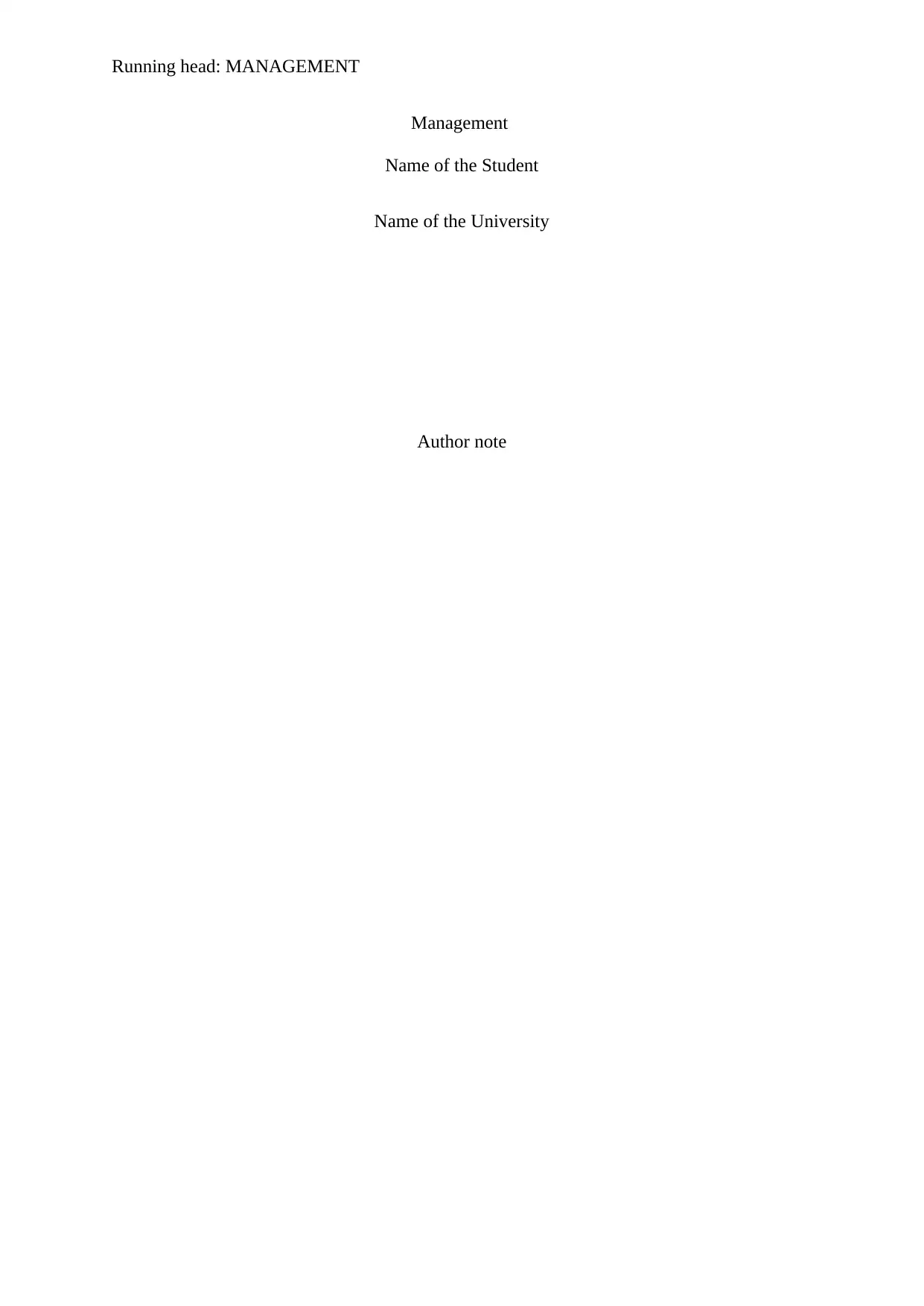
Running head: MANAGEMENT
Management
Name of the Student
Name of the University
Author note
Management
Name of the Student
Name of the University
Author note
Paraphrase This Document
Need a fresh take? Get an instant paraphrase of this document with our AI Paraphraser
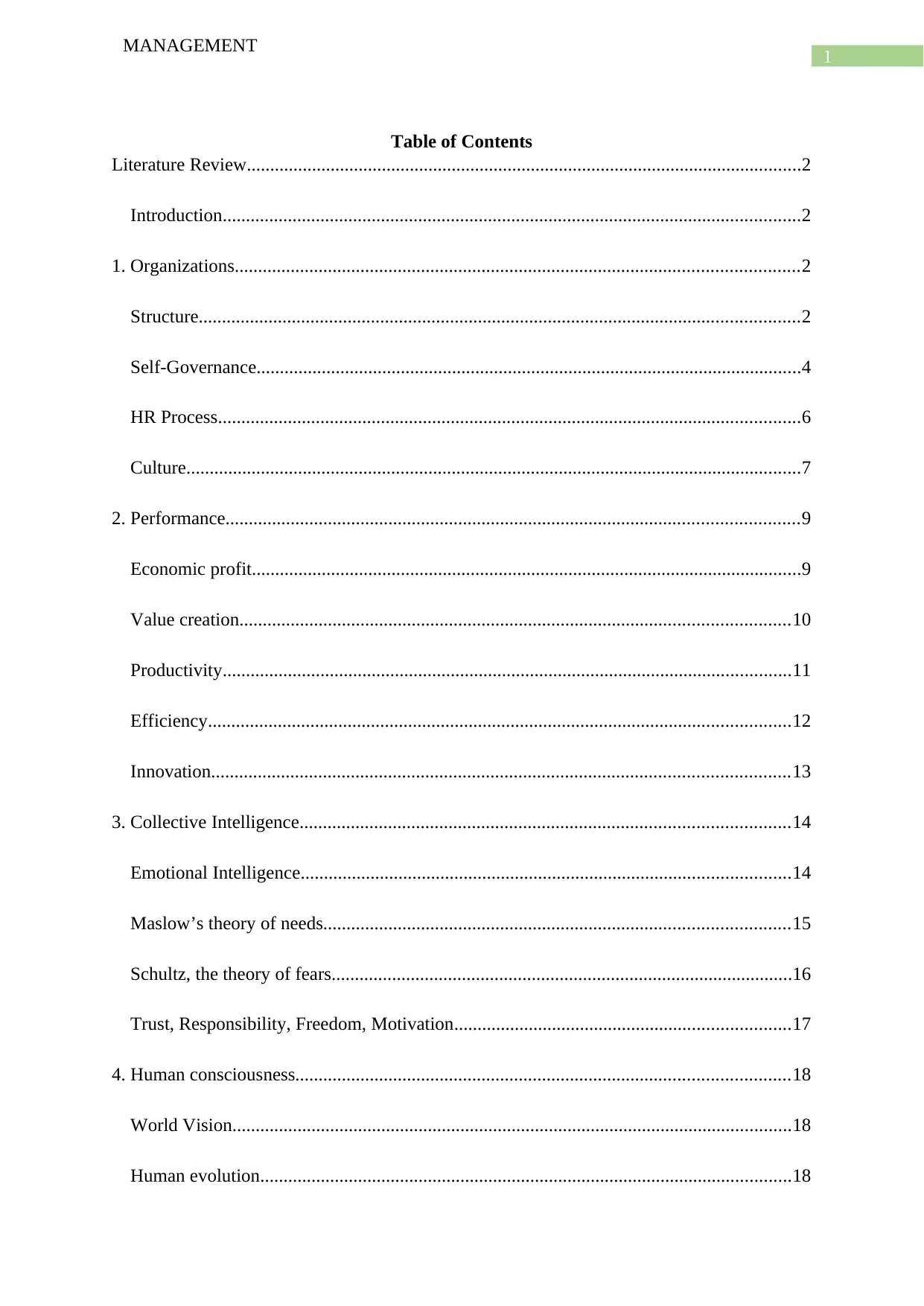
1
MANAGEMENT
Table of Contents
Literature Review.......................................................................................................................2
Introduction............................................................................................................................2
1. Organizations.........................................................................................................................2
Structure.................................................................................................................................2
Self-Governance.....................................................................................................................4
HR Process.............................................................................................................................6
Culture....................................................................................................................................7
2. Performance...........................................................................................................................9
Economic profit......................................................................................................................9
Value creation......................................................................................................................10
Productivity..........................................................................................................................11
Efficiency.............................................................................................................................12
Innovation............................................................................................................................13
3. Collective Intelligence.........................................................................................................14
Emotional Intelligence.........................................................................................................14
Maslow’s theory of needs....................................................................................................15
Schultz, the theory of fears...................................................................................................16
Trust, Responsibility, Freedom, Motivation........................................................................17
4. Human consciousness..........................................................................................................18
World Vision........................................................................................................................18
Human evolution..................................................................................................................18
MANAGEMENT
Table of Contents
Literature Review.......................................................................................................................2
Introduction............................................................................................................................2
1. Organizations.........................................................................................................................2
Structure.................................................................................................................................2
Self-Governance.....................................................................................................................4
HR Process.............................................................................................................................6
Culture....................................................................................................................................7
2. Performance...........................................................................................................................9
Economic profit......................................................................................................................9
Value creation......................................................................................................................10
Productivity..........................................................................................................................11
Efficiency.............................................................................................................................12
Innovation............................................................................................................................13
3. Collective Intelligence.........................................................................................................14
Emotional Intelligence.........................................................................................................14
Maslow’s theory of needs....................................................................................................15
Schultz, the theory of fears...................................................................................................16
Trust, Responsibility, Freedom, Motivation........................................................................17
4. Human consciousness..........................................................................................................18
World Vision........................................................................................................................18
Human evolution..................................................................................................................18
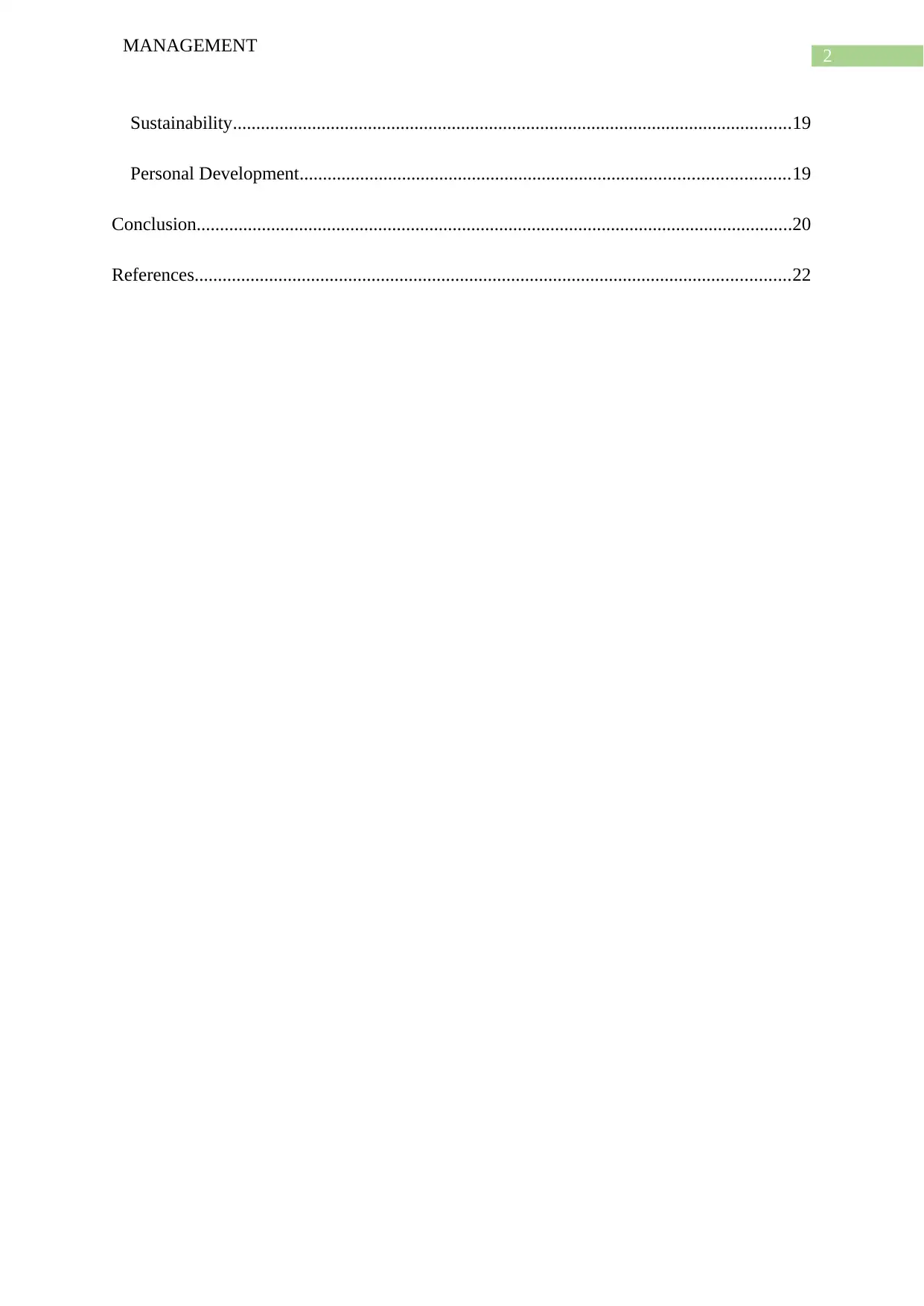
2
MANAGEMENT
Sustainability........................................................................................................................19
Personal Development.........................................................................................................19
Conclusion................................................................................................................................20
References................................................................................................................................22
MANAGEMENT
Sustainability........................................................................................................................19
Personal Development.........................................................................................................19
Conclusion................................................................................................................................20
References................................................................................................................................22
⊘ This is a preview!⊘
Do you want full access?
Subscribe today to unlock all pages.

Trusted by 1+ million students worldwide
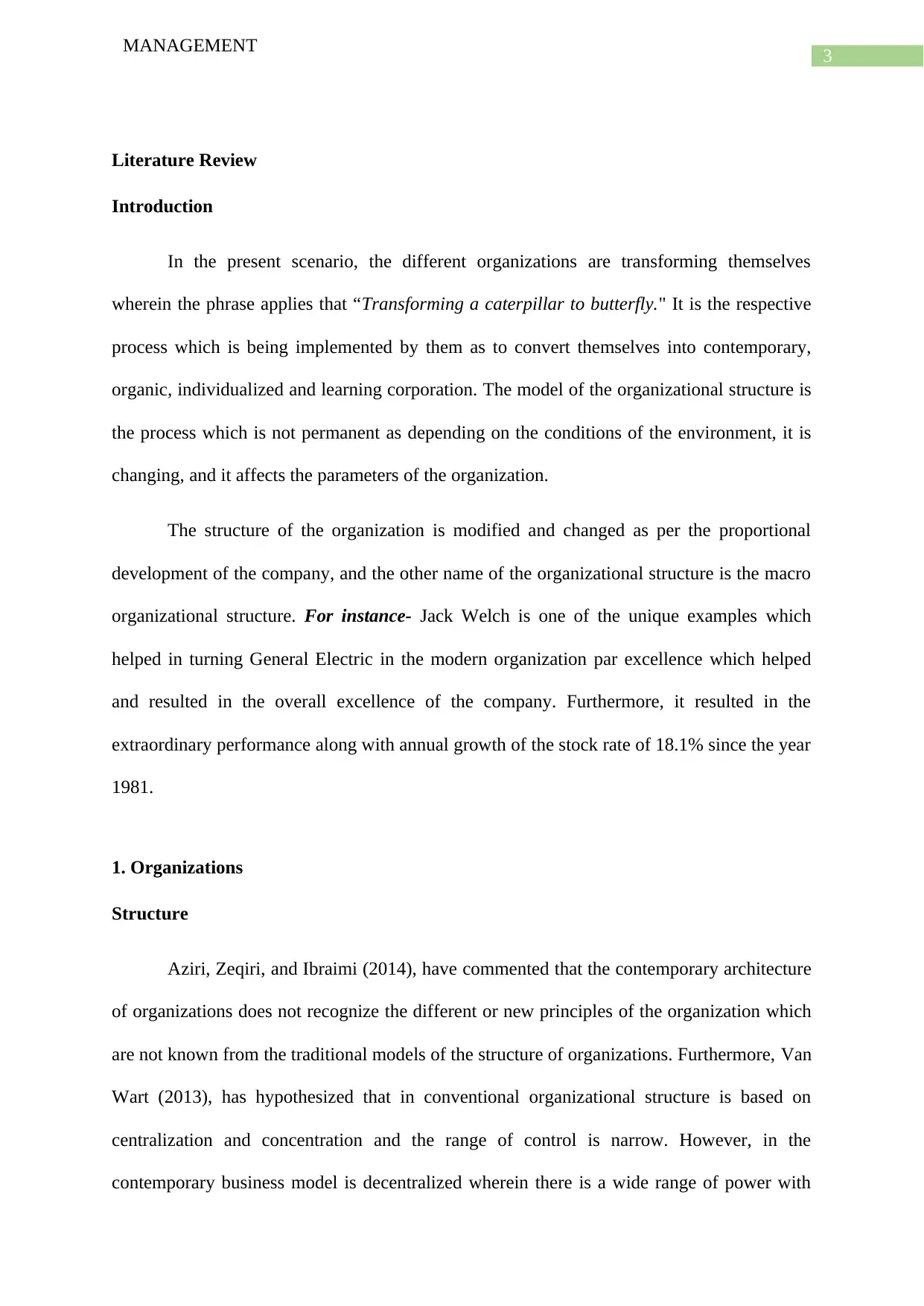
3
MANAGEMENT
Literature Review
Introduction
In the present scenario, the different organizations are transforming themselves
wherein the phrase applies that “Transforming a caterpillar to butterfly." It is the respective
process which is being implemented by them as to convert themselves into contemporary,
organic, individualized and learning corporation. The model of the organizational structure is
the process which is not permanent as depending on the conditions of the environment, it is
changing, and it affects the parameters of the organization.
The structure of the organization is modified and changed as per the proportional
development of the company, and the other name of the organizational structure is the macro
organizational structure. For instance- Jack Welch is one of the unique examples which
helped in turning General Electric in the modern organization par excellence which helped
and resulted in the overall excellence of the company. Furthermore, it resulted in the
extraordinary performance along with annual growth of the stock rate of 18.1% since the year
1981.
1. Organizations
Structure
Aziri, Zeqiri, and Ibraimi (2014), have commented that the contemporary architecture
of organizations does not recognize the different or new principles of the organization which
are not known from the traditional models of the structure of organizations. Furthermore, Van
Wart (2013), has hypothesized that in conventional organizational structure is based on
centralization and concentration and the range of control is narrow. However, in the
contemporary business model is decentralized wherein there is a wide range of power with
MANAGEMENT
Literature Review
Introduction
In the present scenario, the different organizations are transforming themselves
wherein the phrase applies that “Transforming a caterpillar to butterfly." It is the respective
process which is being implemented by them as to convert themselves into contemporary,
organic, individualized and learning corporation. The model of the organizational structure is
the process which is not permanent as depending on the conditions of the environment, it is
changing, and it affects the parameters of the organization.
The structure of the organization is modified and changed as per the proportional
development of the company, and the other name of the organizational structure is the macro
organizational structure. For instance- Jack Welch is one of the unique examples which
helped in turning General Electric in the modern organization par excellence which helped
and resulted in the overall excellence of the company. Furthermore, it resulted in the
extraordinary performance along with annual growth of the stock rate of 18.1% since the year
1981.
1. Organizations
Structure
Aziri, Zeqiri, and Ibraimi (2014), have commented that the contemporary architecture
of organizations does not recognize the different or new principles of the organization which
are not known from the traditional models of the structure of organizations. Furthermore, Van
Wart (2013), has hypothesized that in conventional organizational structure is based on
centralization and concentration and the range of control is narrow. However, in the
contemporary business model is decentralized wherein there is a wide range of power with
Paraphrase This Document
Need a fresh take? Get an instant paraphrase of this document with our AI Paraphraser
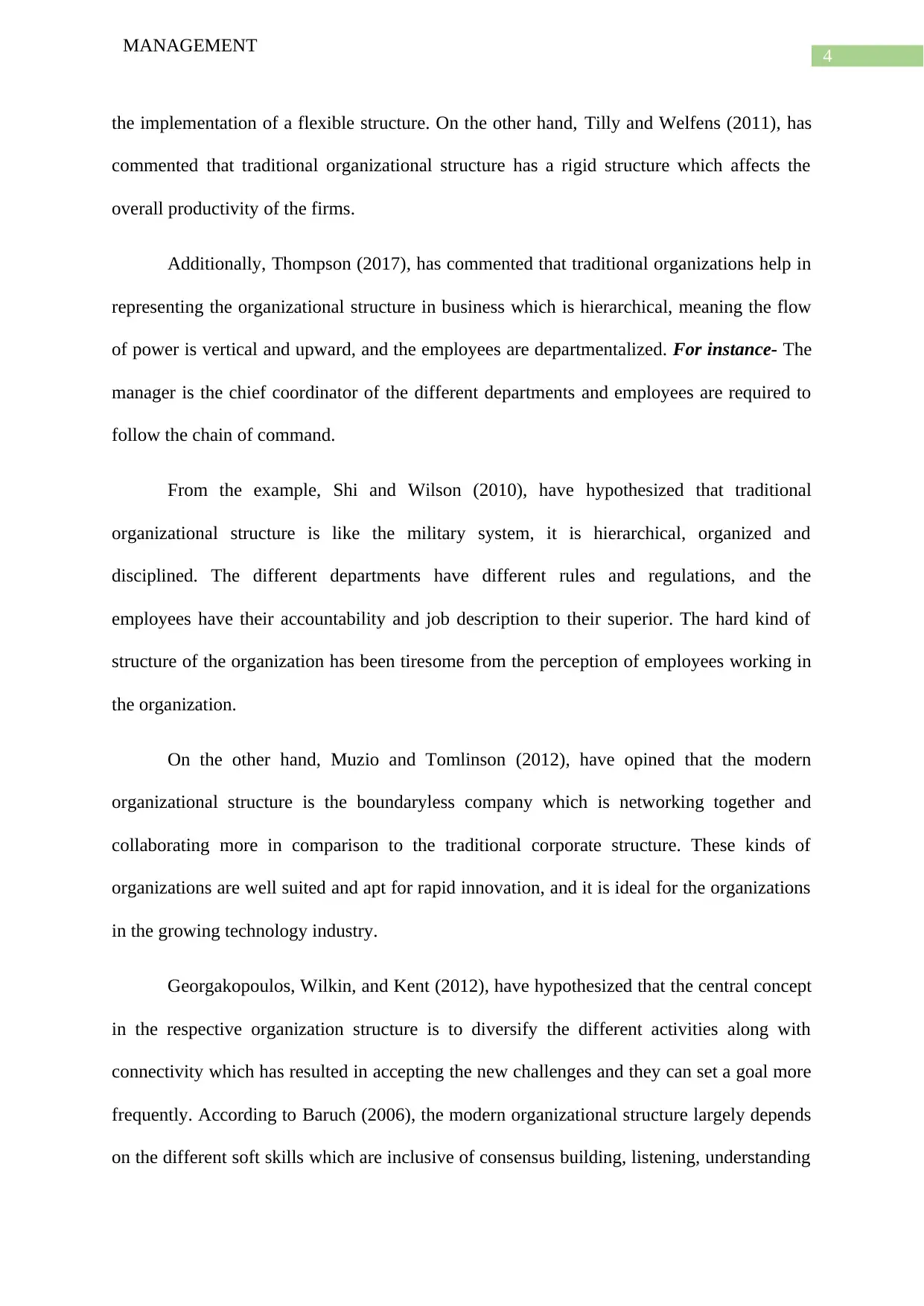
4
MANAGEMENT
the implementation of a flexible structure. On the other hand, Tilly and Welfens (2011), has
commented that traditional organizational structure has a rigid structure which affects the
overall productivity of the firms.
Additionally, Thompson (2017), has commented that traditional organizations help in
representing the organizational structure in business which is hierarchical, meaning the flow
of power is vertical and upward, and the employees are departmentalized. For instance- The
manager is the chief coordinator of the different departments and employees are required to
follow the chain of command.
From the example, Shi and Wilson (2010), have hypothesized that traditional
organizational structure is like the military system, it is hierarchical, organized and
disciplined. The different departments have different rules and regulations, and the
employees have their accountability and job description to their superior. The hard kind of
structure of the organization has been tiresome from the perception of employees working in
the organization.
On the other hand, Muzio and Tomlinson (2012), have opined that the modern
organizational structure is the boundaryless company which is networking together and
collaborating more in comparison to the traditional corporate structure. These kinds of
organizations are well suited and apt for rapid innovation, and it is ideal for the organizations
in the growing technology industry.
Georgakopoulos, Wilkin, and Kent (2012), have hypothesized that the central concept
in the respective organization structure is to diversify the different activities along with
connectivity which has resulted in accepting the new challenges and they can set a goal more
frequently. According to Baruch (2006), the modern organizational structure largely depends
on the different soft skills which are inclusive of consensus building, listening, understanding
MANAGEMENT
the implementation of a flexible structure. On the other hand, Tilly and Welfens (2011), has
commented that traditional organizational structure has a rigid structure which affects the
overall productivity of the firms.
Additionally, Thompson (2017), has commented that traditional organizations help in
representing the organizational structure in business which is hierarchical, meaning the flow
of power is vertical and upward, and the employees are departmentalized. For instance- The
manager is the chief coordinator of the different departments and employees are required to
follow the chain of command.
From the example, Shi and Wilson (2010), have hypothesized that traditional
organizational structure is like the military system, it is hierarchical, organized and
disciplined. The different departments have different rules and regulations, and the
employees have their accountability and job description to their superior. The hard kind of
structure of the organization has been tiresome from the perception of employees working in
the organization.
On the other hand, Muzio and Tomlinson (2012), have opined that the modern
organizational structure is the boundaryless company which is networking together and
collaborating more in comparison to the traditional corporate structure. These kinds of
organizations are well suited and apt for rapid innovation, and it is ideal for the organizations
in the growing technology industry.
Georgakopoulos, Wilkin, and Kent (2012), have hypothesized that the central concept
in the respective organization structure is to diversify the different activities along with
connectivity which has resulted in accepting the new challenges and they can set a goal more
frequently. According to Baruch (2006), the modern organizational structure largely depends
on the different soft skills which are inclusive of consensus building, listening, understanding
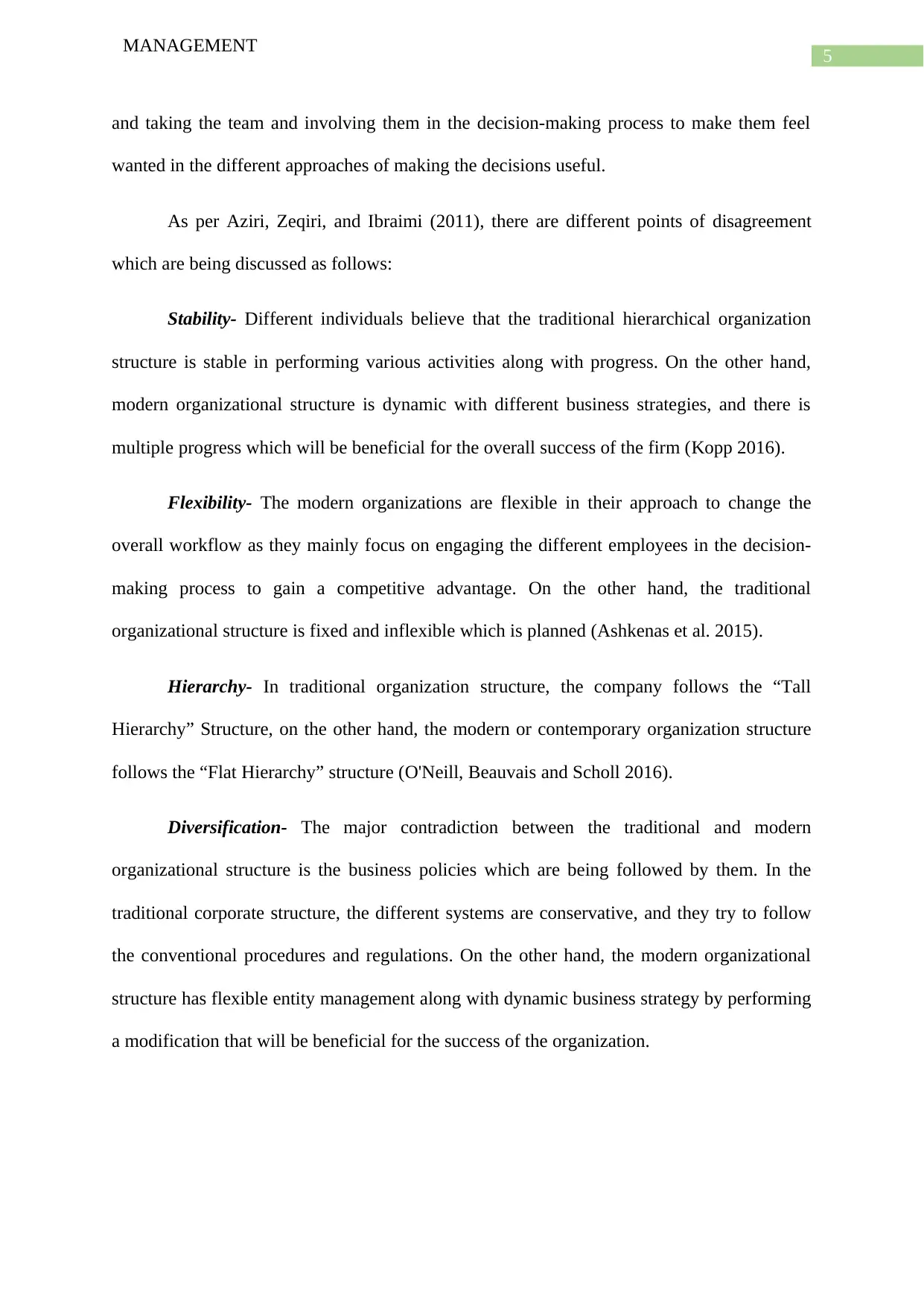
5
MANAGEMENT
and taking the team and involving them in the decision-making process to make them feel
wanted in the different approaches of making the decisions useful.
As per Aziri, Zeqiri, and Ibraimi (2011), there are different points of disagreement
which are being discussed as follows:
Stability- Different individuals believe that the traditional hierarchical organization
structure is stable in performing various activities along with progress. On the other hand,
modern organizational structure is dynamic with different business strategies, and there is
multiple progress which will be beneficial for the overall success of the firm (Kopp 2016).
Flexibility- The modern organizations are flexible in their approach to change the
overall workflow as they mainly focus on engaging the different employees in the decision-
making process to gain a competitive advantage. On the other hand, the traditional
organizational structure is fixed and inflexible which is planned (Ashkenas et al. 2015).
Hierarchy- In traditional organization structure, the company follows the “Tall
Hierarchy” Structure, on the other hand, the modern or contemporary organization structure
follows the “Flat Hierarchy” structure (O'Neill, Beauvais and Scholl 2016).
Diversification- The major contradiction between the traditional and modern
organizational structure is the business policies which are being followed by them. In the
traditional corporate structure, the different systems are conservative, and they try to follow
the conventional procedures and regulations. On the other hand, the modern organizational
structure has flexible entity management along with dynamic business strategy by performing
a modification that will be beneficial for the success of the organization.
MANAGEMENT
and taking the team and involving them in the decision-making process to make them feel
wanted in the different approaches of making the decisions useful.
As per Aziri, Zeqiri, and Ibraimi (2011), there are different points of disagreement
which are being discussed as follows:
Stability- Different individuals believe that the traditional hierarchical organization
structure is stable in performing various activities along with progress. On the other hand,
modern organizational structure is dynamic with different business strategies, and there is
multiple progress which will be beneficial for the overall success of the firm (Kopp 2016).
Flexibility- The modern organizations are flexible in their approach to change the
overall workflow as they mainly focus on engaging the different employees in the decision-
making process to gain a competitive advantage. On the other hand, the traditional
organizational structure is fixed and inflexible which is planned (Ashkenas et al. 2015).
Hierarchy- In traditional organization structure, the company follows the “Tall
Hierarchy” Structure, on the other hand, the modern or contemporary organization structure
follows the “Flat Hierarchy” structure (O'Neill, Beauvais and Scholl 2016).
Diversification- The major contradiction between the traditional and modern
organizational structure is the business policies which are being followed by them. In the
traditional corporate structure, the different systems are conservative, and they try to follow
the conventional procedures and regulations. On the other hand, the modern organizational
structure has flexible entity management along with dynamic business strategy by performing
a modification that will be beneficial for the success of the organization.
⊘ This is a preview!⊘
Do you want full access?
Subscribe today to unlock all pages.

Trusted by 1+ million students worldwide
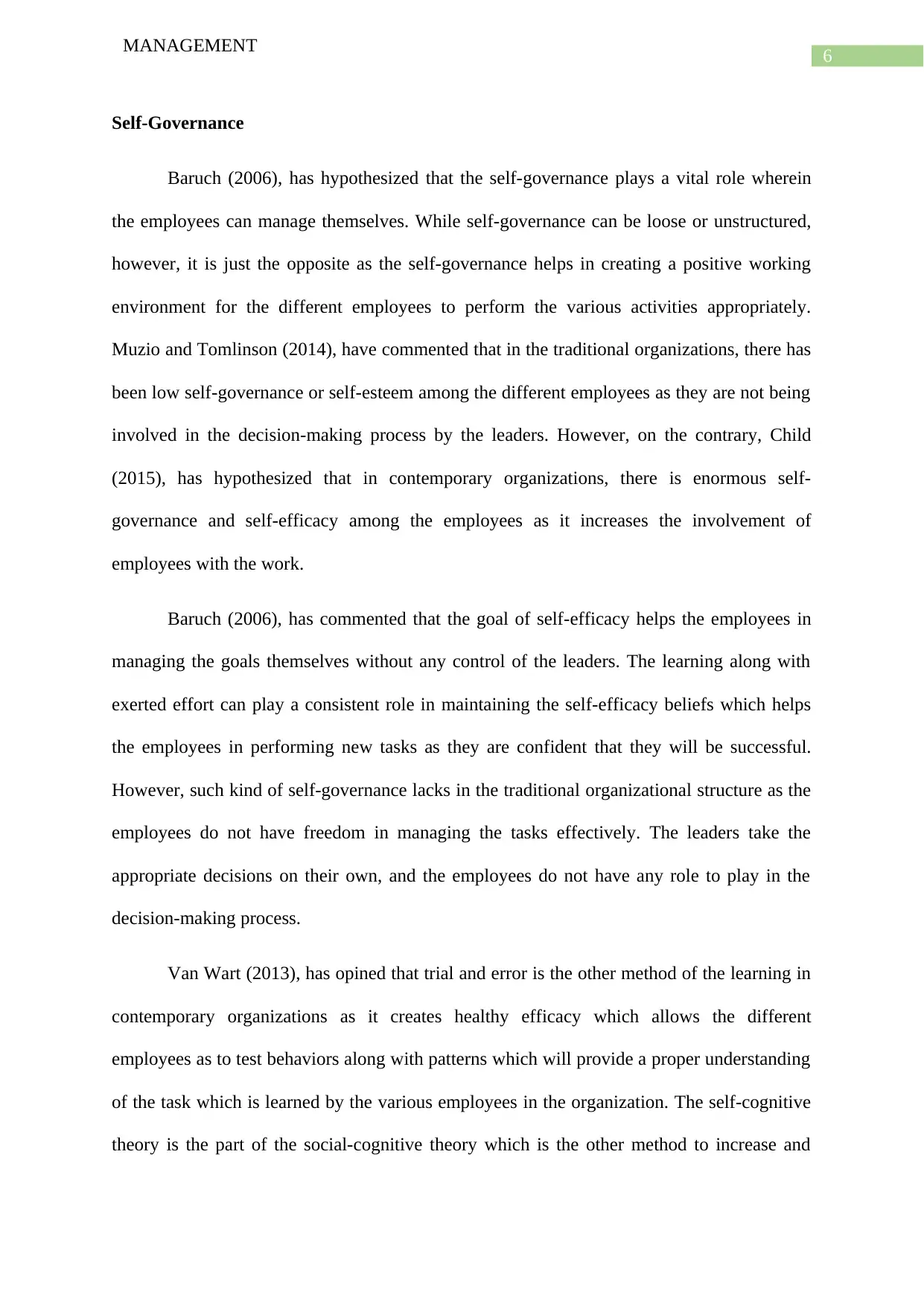
6
MANAGEMENT
Self-Governance
Baruch (2006), has hypothesized that the self-governance plays a vital role wherein
the employees can manage themselves. While self-governance can be loose or unstructured,
however, it is just the opposite as the self-governance helps in creating a positive working
environment for the different employees to perform the various activities appropriately.
Muzio and Tomlinson (2014), have commented that in the traditional organizations, there has
been low self-governance or self-esteem among the different employees as they are not being
involved in the decision-making process by the leaders. However, on the contrary, Child
(2015), has hypothesized that in contemporary organizations, there is enormous self-
governance and self-efficacy among the employees as it increases the involvement of
employees with the work.
Baruch (2006), has commented that the goal of self-efficacy helps the employees in
managing the goals themselves without any control of the leaders. The learning along with
exerted effort can play a consistent role in maintaining the self-efficacy beliefs which helps
the employees in performing new tasks as they are confident that they will be successful.
However, such kind of self-governance lacks in the traditional organizational structure as the
employees do not have freedom in managing the tasks effectively. The leaders take the
appropriate decisions on their own, and the employees do not have any role to play in the
decision-making process.
Van Wart (2013), has opined that trial and error is the other method of the learning in
contemporary organizations as it creates healthy efficacy which allows the different
employees as to test behaviors along with patterns which will provide a proper understanding
of the task which is learned by the various employees in the organization. The self-cognitive
theory is the part of the social-cognitive theory which is the other method to increase and
MANAGEMENT
Self-Governance
Baruch (2006), has hypothesized that the self-governance plays a vital role wherein
the employees can manage themselves. While self-governance can be loose or unstructured,
however, it is just the opposite as the self-governance helps in creating a positive working
environment for the different employees to perform the various activities appropriately.
Muzio and Tomlinson (2014), have commented that in the traditional organizations, there has
been low self-governance or self-esteem among the different employees as they are not being
involved in the decision-making process by the leaders. However, on the contrary, Child
(2015), has hypothesized that in contemporary organizations, there is enormous self-
governance and self-efficacy among the employees as it increases the involvement of
employees with the work.
Baruch (2006), has commented that the goal of self-efficacy helps the employees in
managing the goals themselves without any control of the leaders. The learning along with
exerted effort can play a consistent role in maintaining the self-efficacy beliefs which helps
the employees in performing new tasks as they are confident that they will be successful.
However, such kind of self-governance lacks in the traditional organizational structure as the
employees do not have freedom in managing the tasks effectively. The leaders take the
appropriate decisions on their own, and the employees do not have any role to play in the
decision-making process.
Van Wart (2013), has opined that trial and error is the other method of the learning in
contemporary organizations as it creates healthy efficacy which allows the different
employees as to test behaviors along with patterns which will provide a proper understanding
of the task which is learned by the various employees in the organization. The self-cognitive
theory is the part of the social-cognitive theory which is the other method to increase and
Paraphrase This Document
Need a fresh take? Get an instant paraphrase of this document with our AI Paraphraser
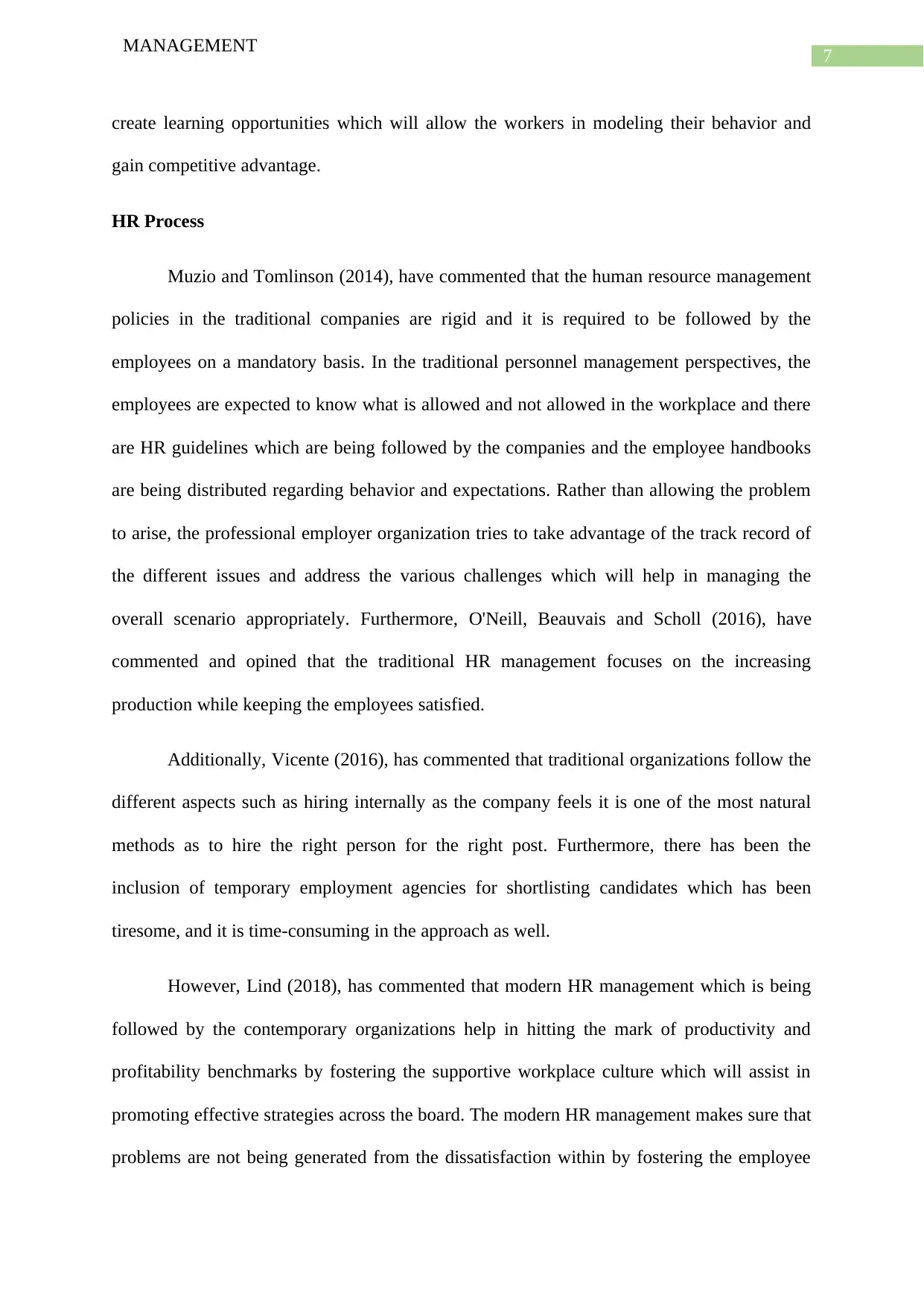
7
MANAGEMENT
create learning opportunities which will allow the workers in modeling their behavior and
gain competitive advantage.
HR Process
Muzio and Tomlinson (2014), have commented that the human resource management
policies in the traditional companies are rigid and it is required to be followed by the
employees on a mandatory basis. In the traditional personnel management perspectives, the
employees are expected to know what is allowed and not allowed in the workplace and there
are HR guidelines which are being followed by the companies and the employee handbooks
are being distributed regarding behavior and expectations. Rather than allowing the problem
to arise, the professional employer organization tries to take advantage of the track record of
the different issues and address the various challenges which will help in managing the
overall scenario appropriately. Furthermore, O'Neill, Beauvais and Scholl (2016), have
commented and opined that the traditional HR management focuses on the increasing
production while keeping the employees satisfied.
Additionally, Vicente (2016), has commented that traditional organizations follow the
different aspects such as hiring internally as the company feels it is one of the most natural
methods as to hire the right person for the right post. Furthermore, there has been the
inclusion of temporary employment agencies for shortlisting candidates which has been
tiresome, and it is time-consuming in the approach as well.
However, Lind (2018), has commented that modern HR management which is being
followed by the contemporary organizations help in hitting the mark of productivity and
profitability benchmarks by fostering the supportive workplace culture which will assist in
promoting effective strategies across the board. The modern HR management makes sure that
problems are not being generated from the dissatisfaction within by fostering the employee
MANAGEMENT
create learning opportunities which will allow the workers in modeling their behavior and
gain competitive advantage.
HR Process
Muzio and Tomlinson (2014), have commented that the human resource management
policies in the traditional companies are rigid and it is required to be followed by the
employees on a mandatory basis. In the traditional personnel management perspectives, the
employees are expected to know what is allowed and not allowed in the workplace and there
are HR guidelines which are being followed by the companies and the employee handbooks
are being distributed regarding behavior and expectations. Rather than allowing the problem
to arise, the professional employer organization tries to take advantage of the track record of
the different issues and address the various challenges which will help in managing the
overall scenario appropriately. Furthermore, O'Neill, Beauvais and Scholl (2016), have
commented and opined that the traditional HR management focuses on the increasing
production while keeping the employees satisfied.
Additionally, Vicente (2016), has commented that traditional organizations follow the
different aspects such as hiring internally as the company feels it is one of the most natural
methods as to hire the right person for the right post. Furthermore, there has been the
inclusion of temporary employment agencies for shortlisting candidates which has been
tiresome, and it is time-consuming in the approach as well.
However, Lind (2018), has commented that modern HR management which is being
followed by the contemporary organizations help in hitting the mark of productivity and
profitability benchmarks by fostering the supportive workplace culture which will assist in
promoting effective strategies across the board. The modern HR management makes sure that
problems are not being generated from the dissatisfaction within by fostering the employee
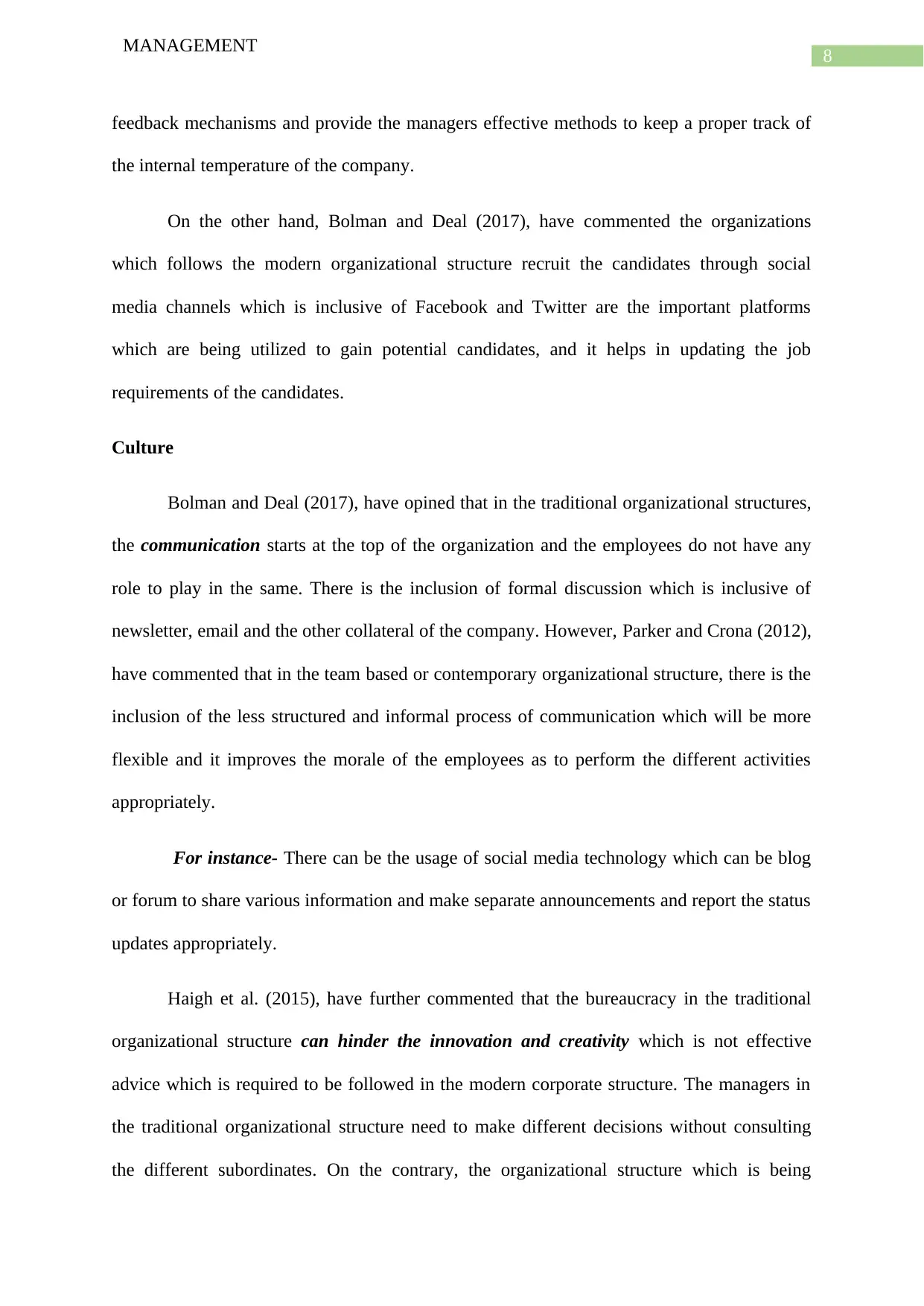
8
MANAGEMENT
feedback mechanisms and provide the managers effective methods to keep a proper track of
the internal temperature of the company.
On the other hand, Bolman and Deal (2017), have commented the organizations
which follows the modern organizational structure recruit the candidates through social
media channels which is inclusive of Facebook and Twitter are the important platforms
which are being utilized to gain potential candidates, and it helps in updating the job
requirements of the candidates.
Culture
Bolman and Deal (2017), have opined that in the traditional organizational structures,
the communication starts at the top of the organization and the employees do not have any
role to play in the same. There is the inclusion of formal discussion which is inclusive of
newsletter, email and the other collateral of the company. However, Parker and Crona (2012),
have commented that in the team based or contemporary organizational structure, there is the
inclusion of the less structured and informal process of communication which will be more
flexible and it improves the morale of the employees as to perform the different activities
appropriately.
For instance- There can be the usage of social media technology which can be blog
or forum to share various information and make separate announcements and report the status
updates appropriately.
Haigh et al. (2015), have further commented that the bureaucracy in the traditional
organizational structure can hinder the innovation and creativity which is not effective
advice which is required to be followed in the modern corporate structure. The managers in
the traditional organizational structure need to make different decisions without consulting
the different subordinates. On the contrary, the organizational structure which is being
MANAGEMENT
feedback mechanisms and provide the managers effective methods to keep a proper track of
the internal temperature of the company.
On the other hand, Bolman and Deal (2017), have commented the organizations
which follows the modern organizational structure recruit the candidates through social
media channels which is inclusive of Facebook and Twitter are the important platforms
which are being utilized to gain potential candidates, and it helps in updating the job
requirements of the candidates.
Culture
Bolman and Deal (2017), have opined that in the traditional organizational structures,
the communication starts at the top of the organization and the employees do not have any
role to play in the same. There is the inclusion of formal discussion which is inclusive of
newsletter, email and the other collateral of the company. However, Parker and Crona (2012),
have commented that in the team based or contemporary organizational structure, there is the
inclusion of the less structured and informal process of communication which will be more
flexible and it improves the morale of the employees as to perform the different activities
appropriately.
For instance- There can be the usage of social media technology which can be blog
or forum to share various information and make separate announcements and report the status
updates appropriately.
Haigh et al. (2015), have further commented that the bureaucracy in the traditional
organizational structure can hinder the innovation and creativity which is not effective
advice which is required to be followed in the modern corporate structure. The managers in
the traditional organizational structure need to make different decisions without consulting
the different subordinates. On the contrary, the organizational structure which is being
⊘ This is a preview!⊘
Do you want full access?
Subscribe today to unlock all pages.

Trusted by 1+ million students worldwide
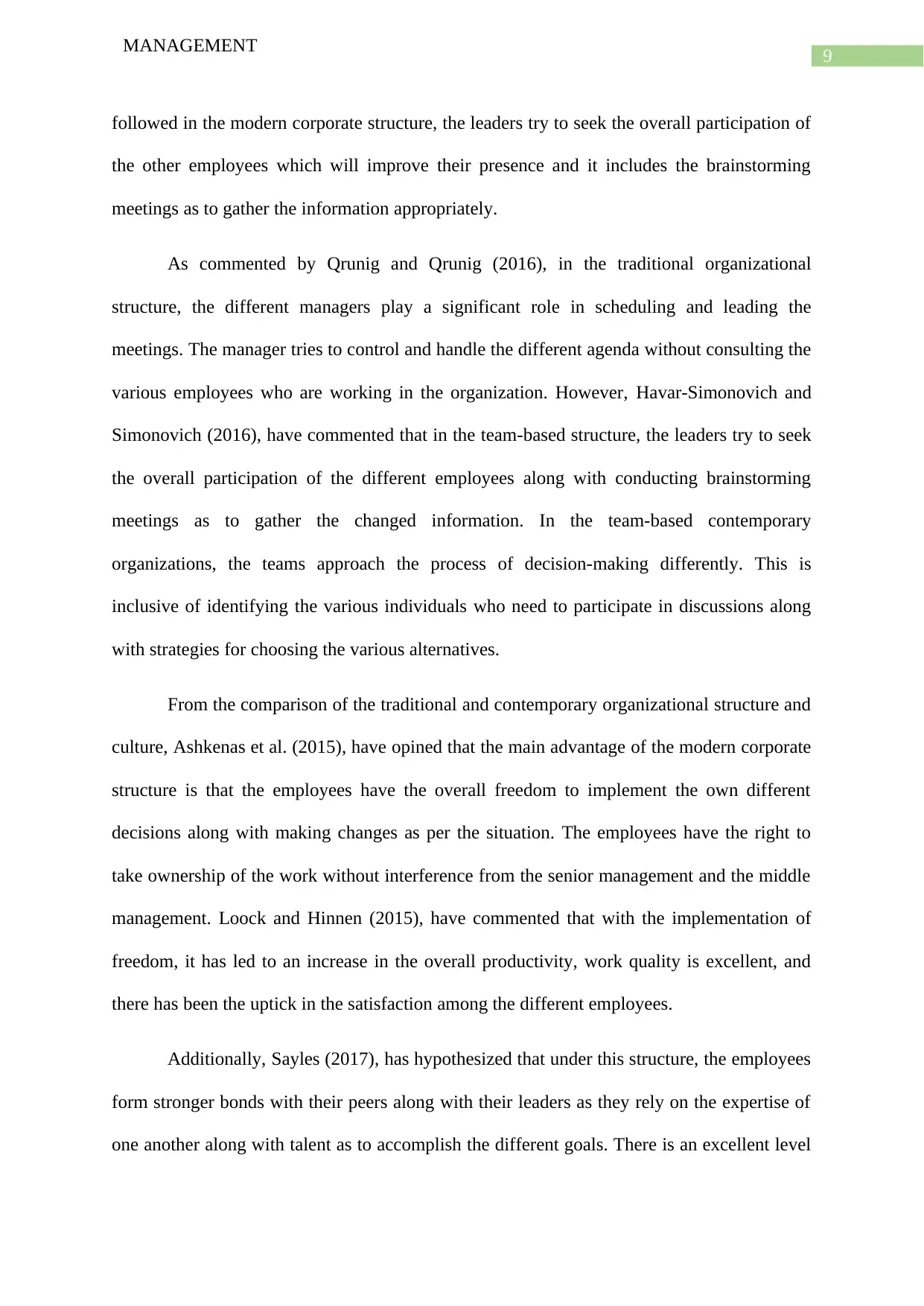
9
MANAGEMENT
followed in the modern corporate structure, the leaders try to seek the overall participation of
the other employees which will improve their presence and it includes the brainstorming
meetings as to gather the information appropriately.
As commented by Qrunig and Qrunig (2016), in the traditional organizational
structure, the different managers play a significant role in scheduling and leading the
meetings. The manager tries to control and handle the different agenda without consulting the
various employees who are working in the organization. However, Havar-Simonovich and
Simonovich (2016), have commented that in the team-based structure, the leaders try to seek
the overall participation of the different employees along with conducting brainstorming
meetings as to gather the changed information. In the team-based contemporary
organizations, the teams approach the process of decision-making differently. This is
inclusive of identifying the various individuals who need to participate in discussions along
with strategies for choosing the various alternatives.
From the comparison of the traditional and contemporary organizational structure and
culture, Ashkenas et al. (2015), have opined that the main advantage of the modern corporate
structure is that the employees have the overall freedom to implement the own different
decisions along with making changes as per the situation. The employees have the right to
take ownership of the work without interference from the senior management and the middle
management. Loock and Hinnen (2015), have commented that with the implementation of
freedom, it has led to an increase in the overall productivity, work quality is excellent, and
there has been the uptick in the satisfaction among the different employees.
Additionally, Sayles (2017), has hypothesized that under this structure, the employees
form stronger bonds with their peers along with their leaders as they rely on the expertise of
one another along with talent as to accomplish the different goals. There is an excellent level
MANAGEMENT
followed in the modern corporate structure, the leaders try to seek the overall participation of
the other employees which will improve their presence and it includes the brainstorming
meetings as to gather the information appropriately.
As commented by Qrunig and Qrunig (2016), in the traditional organizational
structure, the different managers play a significant role in scheduling and leading the
meetings. The manager tries to control and handle the different agenda without consulting the
various employees who are working in the organization. However, Havar-Simonovich and
Simonovich (2016), have commented that in the team-based structure, the leaders try to seek
the overall participation of the different employees along with conducting brainstorming
meetings as to gather the changed information. In the team-based contemporary
organizations, the teams approach the process of decision-making differently. This is
inclusive of identifying the various individuals who need to participate in discussions along
with strategies for choosing the various alternatives.
From the comparison of the traditional and contemporary organizational structure and
culture, Ashkenas et al. (2015), have opined that the main advantage of the modern corporate
structure is that the employees have the overall freedom to implement the own different
decisions along with making changes as per the situation. The employees have the right to
take ownership of the work without interference from the senior management and the middle
management. Loock and Hinnen (2015), have commented that with the implementation of
freedom, it has led to an increase in the overall productivity, work quality is excellent, and
there has been the uptick in the satisfaction among the different employees.
Additionally, Sayles (2017), has hypothesized that under this structure, the employees
form stronger bonds with their peers along with their leaders as they rely on the expertise of
one another along with talent as to accomplish the different goals. There is an excellent level
Paraphrase This Document
Need a fresh take? Get an instant paraphrase of this document with our AI Paraphraser
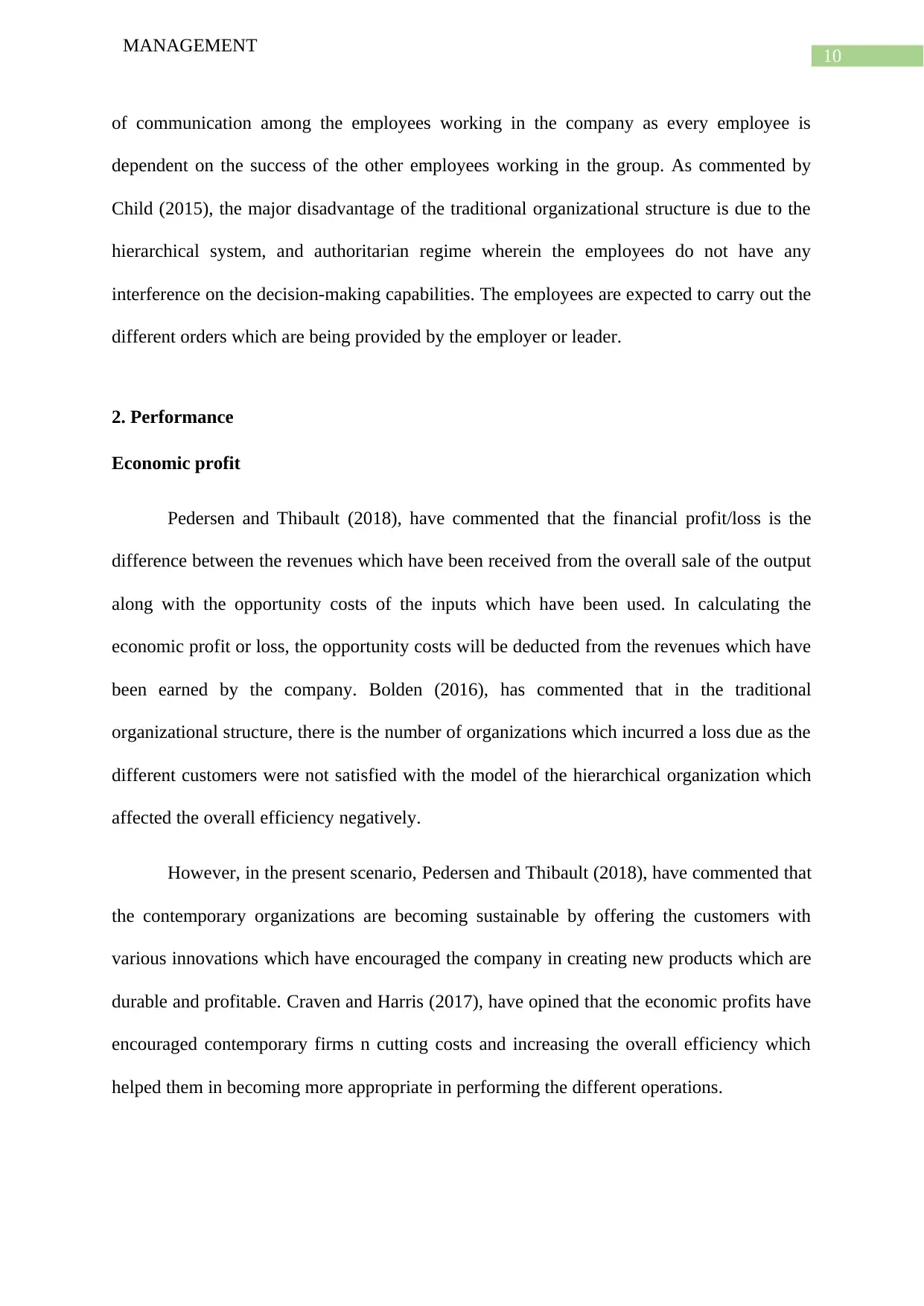
10
MANAGEMENT
of communication among the employees working in the company as every employee is
dependent on the success of the other employees working in the group. As commented by
Child (2015), the major disadvantage of the traditional organizational structure is due to the
hierarchical system, and authoritarian regime wherein the employees do not have any
interference on the decision-making capabilities. The employees are expected to carry out the
different orders which are being provided by the employer or leader.
2. Performance
Economic profit
Pedersen and Thibault (2018), have commented that the financial profit/loss is the
difference between the revenues which have been received from the overall sale of the output
along with the opportunity costs of the inputs which have been used. In calculating the
economic profit or loss, the opportunity costs will be deducted from the revenues which have
been earned by the company. Bolden (2016), has commented that in the traditional
organizational structure, there is the number of organizations which incurred a loss due as the
different customers were not satisfied with the model of the hierarchical organization which
affected the overall efficiency negatively.
However, in the present scenario, Pedersen and Thibault (2018), have commented that
the contemporary organizations are becoming sustainable by offering the customers with
various innovations which have encouraged the company in creating new products which are
durable and profitable. Craven and Harris (2017), have opined that the economic profits have
encouraged contemporary firms n cutting costs and increasing the overall efficiency which
helped them in becoming more appropriate in performing the different operations.
MANAGEMENT
of communication among the employees working in the company as every employee is
dependent on the success of the other employees working in the group. As commented by
Child (2015), the major disadvantage of the traditional organizational structure is due to the
hierarchical system, and authoritarian regime wherein the employees do not have any
interference on the decision-making capabilities. The employees are expected to carry out the
different orders which are being provided by the employer or leader.
2. Performance
Economic profit
Pedersen and Thibault (2018), have commented that the financial profit/loss is the
difference between the revenues which have been received from the overall sale of the output
along with the opportunity costs of the inputs which have been used. In calculating the
economic profit or loss, the opportunity costs will be deducted from the revenues which have
been earned by the company. Bolden (2016), has commented that in the traditional
organizational structure, there is the number of organizations which incurred a loss due as the
different customers were not satisfied with the model of the hierarchical organization which
affected the overall efficiency negatively.
However, in the present scenario, Pedersen and Thibault (2018), have commented that
the contemporary organizations are becoming sustainable by offering the customers with
various innovations which have encouraged the company in creating new products which are
durable and profitable. Craven and Harris (2017), have opined that the economic profits have
encouraged contemporary firms n cutting costs and increasing the overall efficiency which
helped them in becoming more appropriate in performing the different operations.
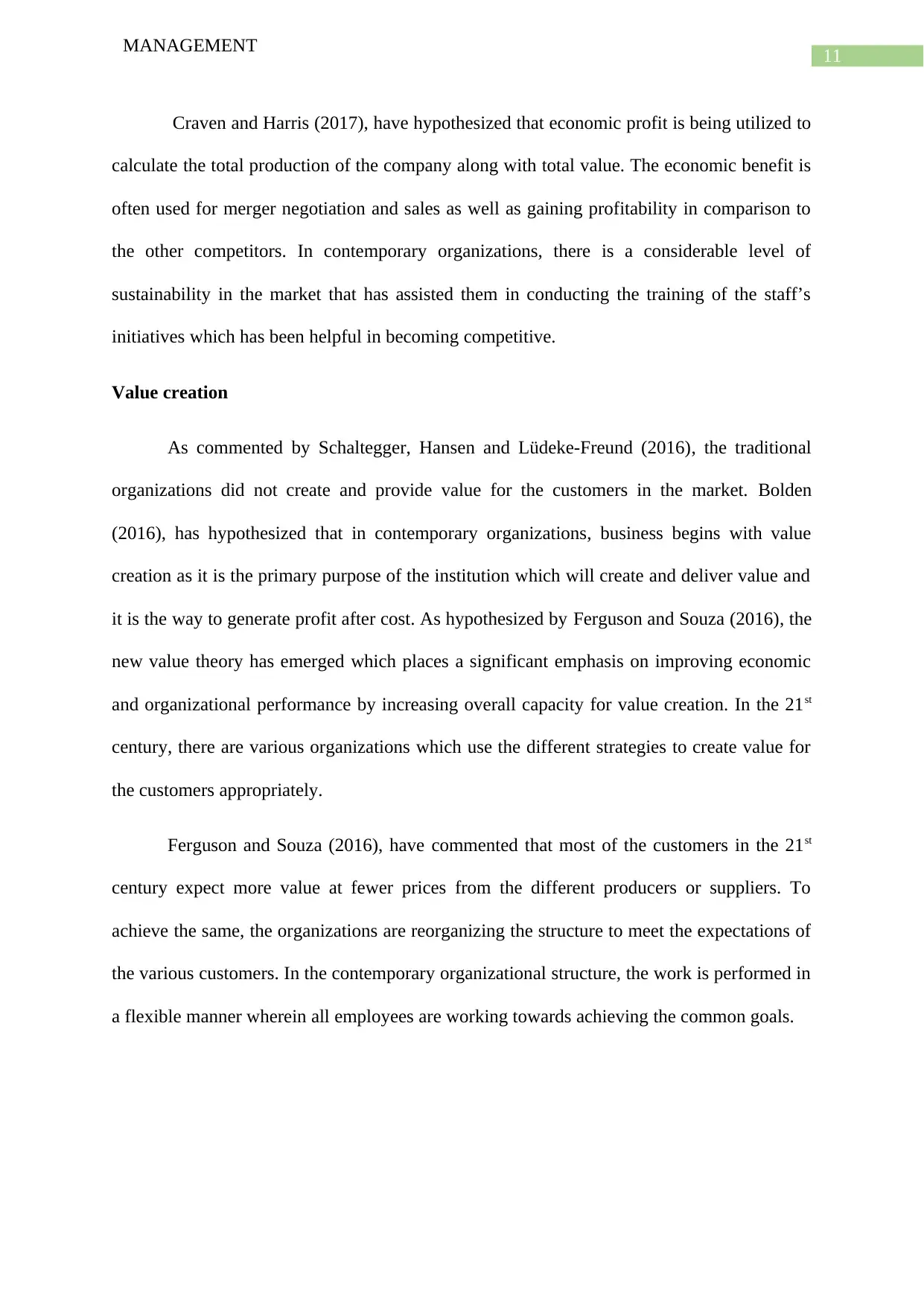
11
MANAGEMENT
Craven and Harris (2017), have hypothesized that economic profit is being utilized to
calculate the total production of the company along with total value. The economic benefit is
often used for merger negotiation and sales as well as gaining profitability in comparison to
the other competitors. In contemporary organizations, there is a considerable level of
sustainability in the market that has assisted them in conducting the training of the staff’s
initiatives which has been helpful in becoming competitive.
Value creation
As commented by Schaltegger, Hansen and Lüdeke-Freund (2016), the traditional
organizations did not create and provide value for the customers in the market. Bolden
(2016), has hypothesized that in contemporary organizations, business begins with value
creation as it is the primary purpose of the institution which will create and deliver value and
it is the way to generate profit after cost. As hypothesized by Ferguson and Souza (2016), the
new value theory has emerged which places a significant emphasis on improving economic
and organizational performance by increasing overall capacity for value creation. In the 21st
century, there are various organizations which use the different strategies to create value for
the customers appropriately.
Ferguson and Souza (2016), have commented that most of the customers in the 21st
century expect more value at fewer prices from the different producers or suppliers. To
achieve the same, the organizations are reorganizing the structure to meet the expectations of
the various customers. In the contemporary organizational structure, the work is performed in
a flexible manner wherein all employees are working towards achieving the common goals.
MANAGEMENT
Craven and Harris (2017), have hypothesized that economic profit is being utilized to
calculate the total production of the company along with total value. The economic benefit is
often used for merger negotiation and sales as well as gaining profitability in comparison to
the other competitors. In contemporary organizations, there is a considerable level of
sustainability in the market that has assisted them in conducting the training of the staff’s
initiatives which has been helpful in becoming competitive.
Value creation
As commented by Schaltegger, Hansen and Lüdeke-Freund (2016), the traditional
organizations did not create and provide value for the customers in the market. Bolden
(2016), has hypothesized that in contemporary organizations, business begins with value
creation as it is the primary purpose of the institution which will create and deliver value and
it is the way to generate profit after cost. As hypothesized by Ferguson and Souza (2016), the
new value theory has emerged which places a significant emphasis on improving economic
and organizational performance by increasing overall capacity for value creation. In the 21st
century, there are various organizations which use the different strategies to create value for
the customers appropriately.
Ferguson and Souza (2016), have commented that most of the customers in the 21st
century expect more value at fewer prices from the different producers or suppliers. To
achieve the same, the organizations are reorganizing the structure to meet the expectations of
the various customers. In the contemporary organizational structure, the work is performed in
a flexible manner wherein all employees are working towards achieving the common goals.
⊘ This is a preview!⊘
Do you want full access?
Subscribe today to unlock all pages.

Trusted by 1+ million students worldwide
1 out of 27
Related Documents
Your All-in-One AI-Powered Toolkit for Academic Success.
+13062052269
info@desklib.com
Available 24*7 on WhatsApp / Email
![[object Object]](/_next/static/media/star-bottom.7253800d.svg)
Unlock your academic potential
Copyright © 2020–2025 A2Z Services. All Rights Reserved. Developed and managed by ZUCOL.





